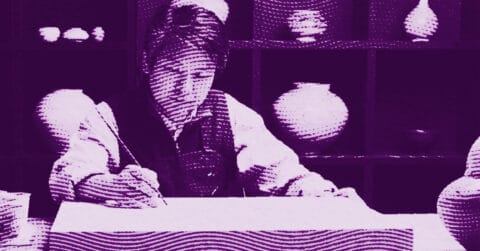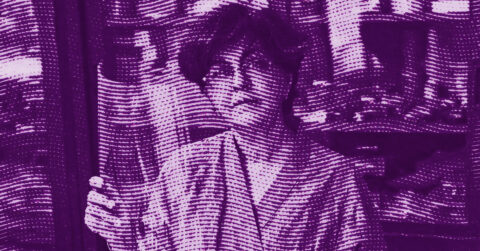Listen to me carefully, you bunch of snobs, when Chinese contemporary art is served to us like a tasting menu in a Michelin-starred restaurant, carefully measured, politically acceptable and aesthetically predictable, it is generally a sign that we should be wary. But Cao Jun, this artist born in 1966 in Jiangyan, Jiangsu province, is of a completely different caliber. He shatters our expectations with an audacity that makes the hairs on my forearms stand up.
Look at his canvases from the “Universe” series and try not to feel drawn into a cosmic vortex of deep blues and flaming gold. Cao Jun is not the type to politely invite you to contemplate a landscape. No, he throws you in headfirst, without a lifebuoy. This is not an invitation, it is a summons.
The exquisite irony in this work lies in the way it manages to marry the ancestral technique of Chinese ink with a quasi-hallucinatory vision of space-time that would have delighted Stephen Hawking. These ink splashes seem to contain the very DNA of the universe. From nebulae to black holes, from spiral galaxies to star explosions, Cao Jun paints the cosmos not as an observed reality but as a lived psychedelic experience.
It is no surprise that his “Universe” series won the gold medal at the Salon du Carrousel du Louvre in 2013. The French have always known how to recognize when someone was shaking up conventions with intelligence rather than gratuitous provocation. And that’s exactly what Cao Jun does.
But curiously, these cosmic explosions evoke for me as much the infinitely large as the infinitely small. Abstraction in Cao Jun refers to Taoist philosophy and this fundamental idea expressed by Lao Tseu that “the very small and the very large meet” [1]. In his paintings like “Turning Around the Universe” or “Opening and Closing”, Cao Jun gives visual form to the Taoist maxim that “the Tao is great, the heaven is great, the earth is great, and man is also great”, four greatnesses that reflect each other.
This approach reminds me of Baudelaire’s concept of “correspondences”, when he wrote in Les Fleurs du Mal that “perfumes, colors and sounds correspond” [2]. Cao Jun establishes similar correspondences between microcosms and macrocosms, between the tangible and the ethereal. The streams of ink on his canvases can evoke both an aerial view of a river delta and a photograph taken by the Hubble telescope.
The trajectory of this artist is as fascinating as his work. Graduating in Mining Engineering from the Shandong University of Science and Technology in 1989, he gradually left this predestined career to devote himself to art. This unconventional path is undoubtedly what gives his work this quality of scientific observation coupled with unbridled artistic freedom of expression.
Look at how he manipulates ink in his series of lotus flowers. These compositions are not just pretty botanical representations. Cao Jun dissects the lotus flower like a biologist analyzing a specimen, but with the sensitivity of a poet. It’s not Linnaeus cataloging species, it’s Rimbaud exploring vowels. I find particularly striking the way he juxtaposes the quasi-photographic precision of details with ink splashes that seem to come from another world, as if objective reality dissolves before our eyes.
In 2002, Cao Jun emigrated to New Zealand and founded a gallery in Auckland. This geographical uprooting coincided with a turning point in his artistic journey. Western influence began to permeate his work, not as a concession to a new market, but as a sincere exploration of new expressive possibilities.
That’s when his work becomes truly exciting for me. He begins to transcend the easy categories of “Oriental art” or “Western art”. He is neither in the pure continuation of the Chinese tradition, nor in the servile imitation of Western codes. He is not in a superficial fusion that dilutes the two traditions. No, Cao Jun creates a visual language that belongs only to him.
His approach reminds me of what the philosopher François Jullien writes about the fundamental differences between Chinese and Western thought. Jullien notes that where Western thought seeks to grasp the essence of things, Chinese thought is more interested in continuous transformations [3]. In Cao Jun’s works, this perspective is manifest: his compositions do not fix a stable reality but capture transitory states, mutations, passages.
Take his “New Song Style” series, where he draws inspiration from Song Dynasty painting (960-1279) while infusing it with contemporary sensibility. This is not a simple nostalgic reproduction, but a vital reinterpretation that makes the centuries dialogue. Traditional mountain landscapes transform into semi-abstract visions where time itself seems suspended. “The old and new times coexist”, as Chinese art critic Shang Hui writes about his work [4].
What I find particularly stimulating is the way Cao Jun uses color. While Chinese tradition often favors subtle variations of black, Cao Jun does not hesitate to employ electric blues, blood reds and flaming golds. This bold chromatism is not gratuitous but serves his cosmic vision. His signature blue, literally called “Cao Jun blue”, has become his trademark, to the point of being marketed by a Western art supply company. It is a blue that evokes both ocean depths and celestial vastness.
This palette is not without recalling the experiments of Vassily Kandinsky, who sought to explore the spiritual and emotional properties of colors [5]. Cao Jun shares this conviction that color is not merely decorative but possesses a metaphysical dimension. His blue is not just blue, it is a gateway to other dimensions of consciousness.
In his more recent works, Cao Jun integrates materials such as gold leaf, creating surfaces that change according to the viewing angle and light. These works become almost interactive, inviting the viewer to move around to capture all the nuances. This cinematic quality adds a temporal dimension to his work, a fourth dimension that transcends the two-dimensional surface.
But do not be mistaken, Cao Jun is not just a virtuoso technician or a juggler of styles. Behind the formal beauty lies a profound questioning of our place in the universe. His cosmic landscapes confront us with our insignificance in the face of the immensity of the cosmos, while reminding us that we are made of the same matter as the stars.
This tension between the infinite and the finite, between the ephemeral and the eternal, runs through all his work. It reminds me of what the philosopher Emil Cioran wrote in “The Fall into Time”: “We oscillate between one abyss and another, between two equally hostile infinities” [6]. The swirls of ink and color in Cao Jun seem to visualize this vertiginous oscillation.
But beware, if I speak to you of philosophy and cosmology, it is not to over-intellectualize a work that functions first on a visual level. Cao Jun is not an illustrator of abstract ideas. His works hit you first in the gut before rising to the brain. They are sensual, tactile, almost carnal in their materiality.
That is perhaps where his greatest feat lies: reconciling the sensible and the intelligible, the body and the spirit, in a single artistic gesture. In a world of contemporary art where one often feels compelled to choose between meaningless beauty and arid conceptuality, Cao Jun reminds us that it is possible to think with the senses and feel with the intellect.
His initial training in engineering gave him an intimate understanding of materials, their chemical composition and physical properties. He approaches painting with the precision of a scientist and the freedom of a poet. This duality is particularly evident in his way of manipulating mineral pigments, of which he exploits the unpredictable reactions with water and ink.
One could see in this approach a metaphor for his position at the crossroads of cultures. Neither completely Chinese in his practice, nor Westernized in his vision, Cao Jun occupies this fecund space of the in-between, where apparent contradictions dissolve to give way to a new synthesis.
This positioning reminds me of the notion of “third space” theorized by Homi Bhabha, that liminal space which is neither one nor the other, but something new and hybrid [7]. Cao Jun’s works perfectly embody this “third space” cultural and aesthetic, where traditions dialogue without diluting.
His geographical journey, from China to New Zealand and then to the United States, reflects this artistic trajectory. He is a nomadic artist, not only physically but also intellectually and spiritually. He crosses borders like his inks cross paper, with fluidity and determination.
In 2018, the McMullen Museum of Art in Boston dedicated a major exhibition to his work, titled “Cao Jun: Hymns to Nature”. This title is revealing. Despite all its technical and conceptual sophistication, Cao Jun’s art remains fundamentally a hymn to nature, not the domesticated and picturesque nature of postcards, but nature in its cosmic, mysterious and sometimes terrifying dimension.
This exhibition, curated by philosopher John Sallis and art historian Nancy Netzer, highlighted the philosophical dimension of his work. As Sallis writes, “Cao Jun’s works are a visual meditation on the relationship between the human and the cosmos” [8]. This meditation is not abstract but incarnate in the very matter of the painting.
In a world of contemporary art often cynical and self-referential, Cao Jun’s work offers a breath of fresh air, or rather, a plunge into the oceanic and celestial depths. It reminds us that art can still amaze us, disorient us and reconnect us to something greater than ourselves.
So the next time you come across a work by Cao Jun, do not just admire it politely as a beautiful decorative object. Let yourself be overwhelmed by his waves of ink, lose yourself in his cosmic blues, and perhaps, just perhaps, you will feel that metaphysical thrill that only great art can provoke.
- Lao Tseu, “Tao Te King”, translation by Liou Kia-hway, Gallimard, 1967.
- Charles Baudelaire, “Les Fleurs du Mal”, poem “Correspondances”, 1857.
- François Jullien, “Procès ou création. Une introduction à la pensée des lettrés chinois”, Seuil, 1989.
- Shang Hui, “Cao Jun: In Search of Deep Philosophical Meaning in the Creation of Ink Painting”, Journal of Chinese Culture, 2024.
- Vassily Kandinsky, “Concerning the Spiritual in Art”, Denoël, 1954.
- Emil Cioran, “La Chute dans le temps”, Gallimard, 1964.
- Homi K. Bhabha, “The Location of Culture”, Payot, 2007.
- John Sallis, “Cao Jun: Hymns to Nature”, exhibition catalog, McMullen Museum of Art, Boston College, 2018.
















